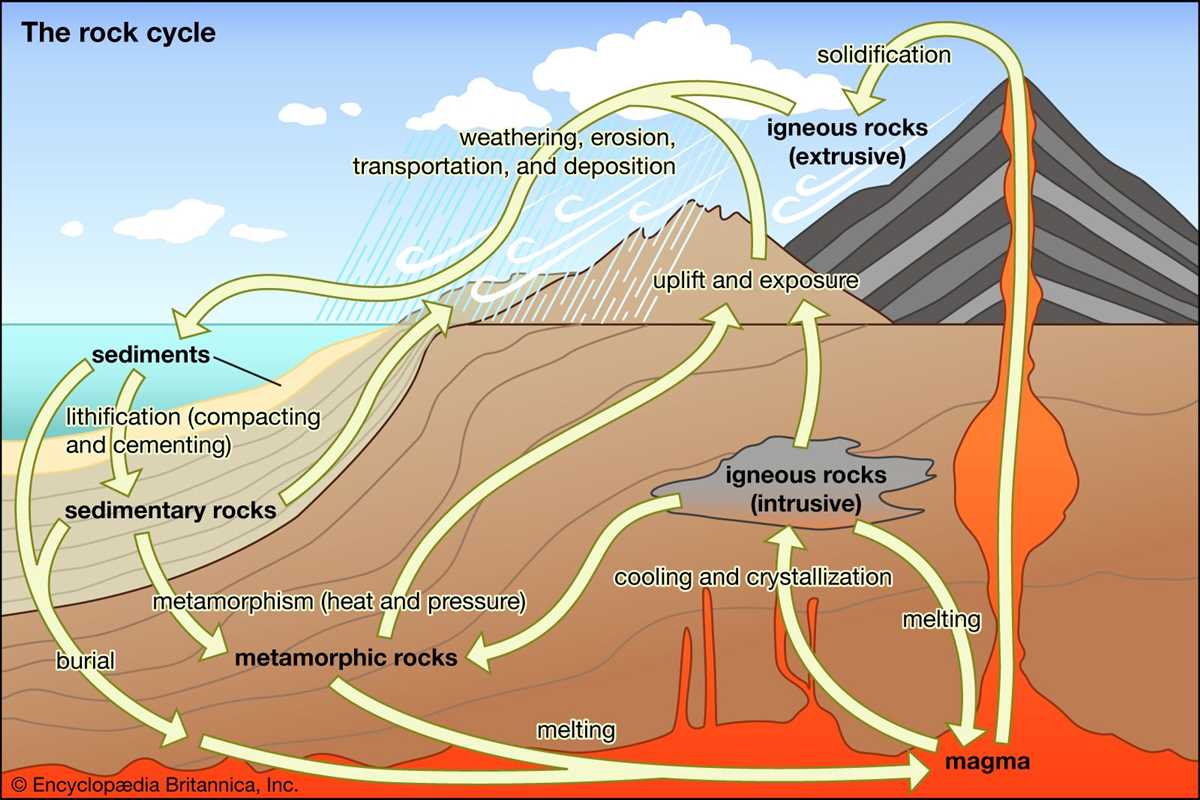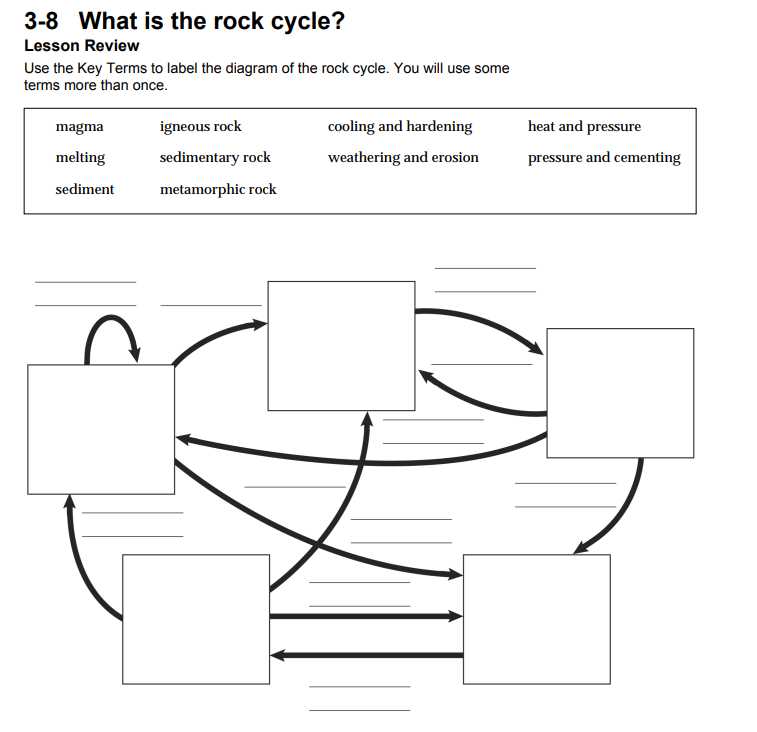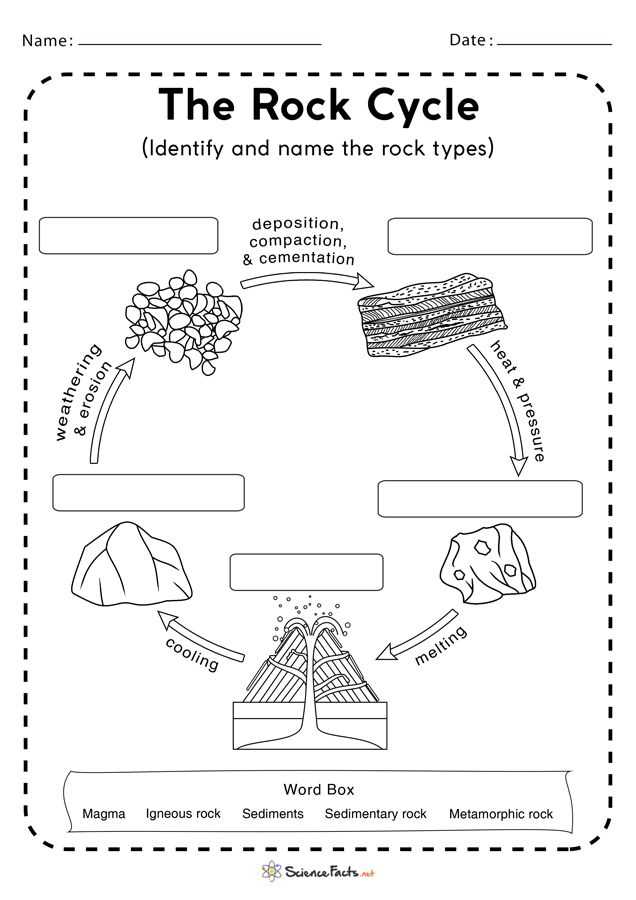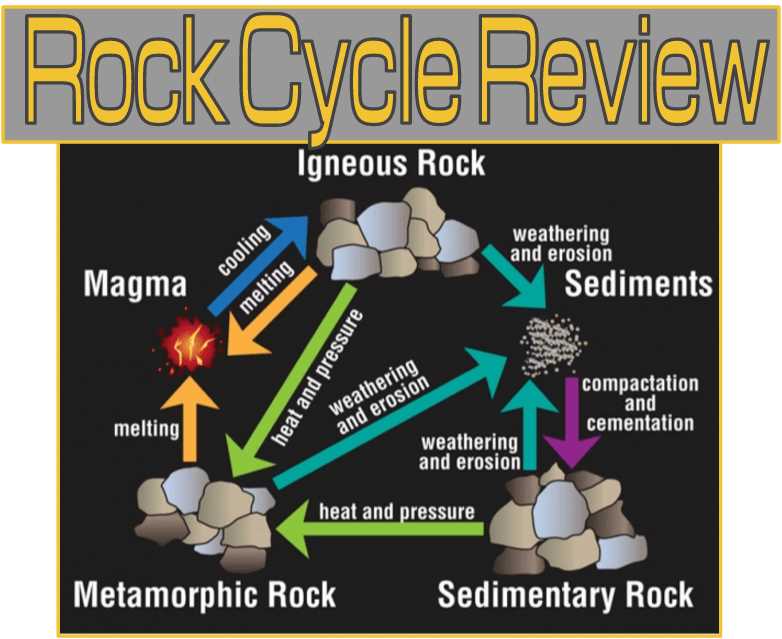
In the study of geology, rocks play a fundamental role. They give us insight into the Earth’s history, provide evidence of past environments, and even have economic importance. Understanding rocks and the rock cycle is crucial for geologists, as it allows them to decipher the geological history of an area. In this lesson, we will explore the different types of rocks and the processes that transform one rock type into another.
First, let’s define what a rock is. A rock is a naturally occurring solid material composed of one or more minerals. There are three main types of rocks: igneous, sedimentary, and metamorphic. Igneous rocks form when molten material cools and solidifies. Sedimentary rocks result from the deposition and compaction of sediments, such as sand and mud. Lastly, metamorphic rocks form when existing rocks undergo intense heat and pressure, causing their minerals to change.
The rock cycle is a continuous process of formation, transformation, and destruction of rocks. It involves three main processes: weathering and erosion, deposition and lithification, and metamorphism. Weathering and erosion break down rocks into smaller pieces, which are then transported and deposited by wind, water, or ice. In the next step, these sediments undergo compaction and cementation, turning them into sedimentary rocks. Over time, these sedimentary rocks can be subjected to heat and pressure, leading to their transformation into metamorphic rocks. Finally, through the process of melting and solidification, metamorphic rocks can become molten material and form igneous rocks, starting the cycle anew.
Rocks and the Rock Cycle Lesson 1 Answer Key

In Lesson 1, we explored the basics of rocks and the rock cycle. We learned that rocks are made up of minerals and can be classified into three main types: igneous, sedimentary, and metamorphic. We also learned that the rock cycle is the continuous process of how rocks change from one type to another over time.
Key Concepts:
- Minerals are the building blocks of rocks and are naturally occurring, inorganic solids with a specific chemical composition and crystal structure.
- Igneous rocks form when molten rock (magma or lava) cools and solidifies. They can be classified into two main types: intrusive (formed underground) and extrusive (formed on the Earth’s surface).
- Sedimentary rocks are formed from the accumulation and cementation of sediments, which can include pieces of other rocks, minerals, and organic materials. They can be further classified into three main types: clastic, chemical, and organic.
- Metamorphic rocks are formed when existing rocks undergo changes in temperature, pressure, or the presence of fluids. This can cause the minerals in the rocks to recrystallize and change their characteristics.
- The rock cycle is a continuous process that describes how rocks change from one type to another over time. It involves processes such as weathering, erosion, deposition, compaction, and cementation.
Answer Key:
- Igneous rocks form when molten rock cools and solidifies. They can be classified into intrusive and extrusive types.
- Sedimentary rocks are formed from the accumulation and cementation of sediments. They can be clastic, chemical, or organic in nature.
- Metamorphic rocks are formed from the transformation of existing rocks under high temperature and pressure.
- The rock cycle is the continuous process of how rocks change from one type to another over time.
- Minerals are the building blocks of rocks and have specific chemical compositions and crystal structures.
Overall, Lesson 1 provided a solid foundation for understanding the different types of rocks and how they form. By understanding the rock cycle, we can appreciate the constant changes and transformations that occur on Earth’s surface.
The Definition and Types of Rocks
Rocks are solid, natural materials that form the Earth’s crust. They are made up of minerals, which are solid substances with a specific chemical composition. Rocks are classified into three major types: igneous, sedimentary, and metamorphic.
Igneous rocks are formed from the cooling and solidification of molten lava or magma. When magma or lava cools and hardens, it forms crystals that make up the igneous rock. Examples of igneous rocks include granite, basalt, and obsidian. Igneous rocks can be further classified into intrusive (formed underground) and extrusive (formed on the surface) types.
Sedimentary rocks are formed from the accumulation and lithification of sediments. Sediments are weathered fragments of pre-existing rocks, minerals, or organic matter that have been transported and deposited by wind, water, or ice. Over time, the sediments are compacted and cemented together, forming sedimentary rocks. Examples of sedimentary rocks include sandstone, limestone, and shale. Sedimentary rocks can be further classified into clastic, chemical, and organic types.
Metamorphic rocks are formed from the transformation of existing rocks under high pressure, high temperature, or both. The minerals in the rocks undergo chemical reactions, resulting in the formation of new minerals, textures, and structures. Examples of metamorphic rocks include marble, schist, and slate. Metamorphic rocks can be further classified into foliated and non-foliated types.
It is important to understand the different types of rocks and their characteristics because they provide valuable information about the Earth’s history and processes. The study of rocks also helps scientists understand the rock cycle, which is the continuous process of rock formation, transformation, and recycling.
Key Characteristics of Igneous Rocks
Igneous rocks are formed when molten rock material, called magma, cools and solidifies. They are one of the three main types of rocks found in the Earth’s crust, along with sedimentary and metamorphic rocks. Igneous rocks can have a variety of key characteristics that help geologists identify and classify them.
Texture: One important characteristic of igneous rocks is their texture, which describes the size and arrangement of the mineral grains within the rock. There are two main types of igneous rock textures: intrusive and extrusive. Intrusive rocks, also known as plutonic rocks, form when magma cools slowly beneath the Earth’s surface, allowing large mineral grains to develop. Extrusive rocks, or volcanic rocks, form when magma erupts onto the Earth’s surface and cools quickly, resulting in smaller mineral grains.
Composition: Another key characteristic of igneous rocks is their composition, which refers to the types and proportion of minerals present. Igneous rocks are primarily made up of silicate minerals, such as quartz, feldspar, and mica. The exact composition of an igneous rock can vary depending on factors like the original magma source and the cooling rate. Geologists use various tests and observations, such as color, hardness, and mineral identification, to determine the composition of an igneous rock.
Classification: Igneous rocks can be further classified based on their texture and composition. The classification system used by geologists is called the QAPF diagram, which stands for quartz, alkali feldspar, plagioclase feldspar. This diagram helps determine the mineral composition of igneous rocks and categorizes them into different groups, such as granites, basalts, and andesites.
Uses: Igneous rocks have various uses in construction, industry, and art. Some igneous rocks, like granite and basalt, are commonly used as building materials or in the production of countertops, flooring, and decorative items. Rocks like obsidian, which is a type of volcanic glass, have been used by ancient cultures for making tools and weapons. Igneous rocks also have economic importance as sources of valuable minerals, such as gold, silver, and copper.
Overall, the key characteristics of igneous rocks – texture, composition, classification, and uses – provide valuable insights not only into the geological history of the Earth but also into their practical applications in our everyday lives.
Key Characteristics of Sedimentary Rocks

Sedimentary rocks are a type of rock that forms from the accumulation and lithification of sediment. Unlike igneous and metamorphic rocks, which form from molten material or through the alteration of existing rocks, sedimentary rocks are formed through the process of weathering, erosion, deposition, compaction, and cementation.
There are several key characteristics that define sedimentary rocks. First, sedimentary rocks are composed of sediment, which consists of broken down fragments of preexisting rocks, minerals, and organic materials. These sediments can include sand, silt, clay, and various other particles.
- Layers: Sedimentary rocks often exhibit distinct layers, or strata, which are the result of the deposition and compaction of different sedimentary materials over time. These layers can provide valuable information about Earth’s history and the conditions under which the rock formed.
- Fossils: Sedimentary rocks are known for their ability to preserve fossils. The process of sedimentation can often trap and preserve the remains of plants and animals, offering insights into past life forms and environments.
- Texture: While sedimentary rocks can have a variety of textures, they typically have a more granular and clastic texture compared to igneous and metamorphic rocks. This is due to the fact that sediment is often made up of loosely packed particles that become compacted and cemented over time.
- Composition: Sedimentary rocks can be made up of a wide range of minerals and materials, depending on the source of the sediments. Common minerals found in sedimentary rocks include quartz, feldspar, and clay minerals.
In conclusion, sedimentary rocks are characterized by their formation through the accumulation and lithification of sediment. They are composed of various sedimentary materials, exhibit distinct layers, can preserve fossils, have a granular texture, and can be made up of different minerals and materials. Understanding these key characteristics can help scientists interpret the history and processes that have shaped our planet.
Key Characteristics of Metamorphic Rocks
Metamorphic rocks are a type of rock that is formed by the transformation of existing rocks under high pressure and temperature conditions. These rocks undergo significant changes in their mineralogy, texture, and structure, giving them unique characteristics that distinguish them from other types of rocks.
One key characteristic of metamorphic rocks is their foliated or non-foliated texture. Foliated rocks have a layered or banded appearance due to the alignment of minerals in parallel planes. This texture is created by the intense pressure and heat that causes the minerals to recrystallize and align. Non-foliated rocks, on the other hand, lack visible layers or bands and have a more uniform texture. This difference in texture is a result of the minerals recrystallizing without significant deformation.
Another important characteristic of metamorphic rocks is their mineral composition. Depending on the parent rock and the specific conditions of metamorphism, different minerals can form or recrystallize. Some common minerals found in metamorphic rocks include quartz, feldspar, mica, and garnet. The presence and distribution of these minerals can provide clues about the temperature and pressure conditions that the rock experienced during metamorphism.
In addition to texture and mineral composition, metamorphic rocks also exhibit distinct banding, folding, and deformation structures. These features are a result of the intense pressure and heat that the rock was subjected to during metamorphism. Banding refers to the visible layers or bands that are formed by the alignment of minerals, while folding and deformation structures occur when the rock is deformed and twisted under extreme pressure.
Overall, metamorphic rocks are characterized by their unique texture, mineral composition, and structural features, which are a result of the complex processes of metamorphism. Understanding these characteristics can provide valuable insights into the geological history and conditions that the rocks have undergone.
The Rock Cycle and its Stages

The rock cycle is a continuous process that describes how rocks are formed, changed, and reformed over time. It showcases the interconnectedness of the three major rock types: igneous, sedimentary, and metamorphic rocks. The rock cycle is driven by various geological processes, including weathering, erosion, heat, pressure, and melting.
The rock cycle consists of three main stages: rock formation, rock transformation, and rock recycling. In the rock formation stage, igneous rocks are formed through the cooling and solidification of molten magma or lava. This process can occur both beneath the Earth’s surface and on the surface, resulting in different types of igneous rocks.
In the rock transformation stage, existing rocks undergo changes due to heat, pressure, and/or chemical reactions. Sedimentary rocks are formed through the accumulation and cementation of sediments, which can be derived from the weathering and erosion of other rocks or the remains of living organisms. Metamorphic rocks are formed from the alteration of pre-existing rocks through intense heat and pressure.
In the rock recycling stage, rocks are broken down through weathering and erosion, transported, and then deposited in new locations. These sediments can become lithified and compacted into sedimentary rocks, completing the cycle. The tectonic movements of the Earth’s crust can also result in the subduction or uplift of rocks, leading to their exposure to new geological processes and potential transformation into metamorphic or igneous rocks.
The rock cycle is an important concept in geology as it helps us understand the dynamic nature of Earth’s surface and the formation of its diverse rock types. By studying the rock cycle, scientists can unravel the history of our planet and make predictions about future geological events. It is a fundamental process that highlights the continuous and cyclical nature of Earth’s geology.
Overall, the rock cycle demonstrates how rocks constantly change and transform, highlighting the interconnectedness and cyclical nature of Earth’s geology. It is a dynamic and ongoing process that shapes our planet’s surface and provides valuable insights into its history.